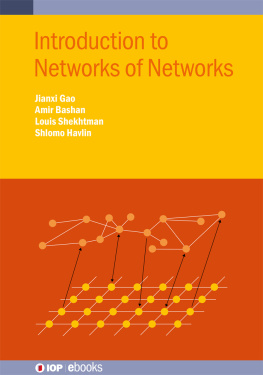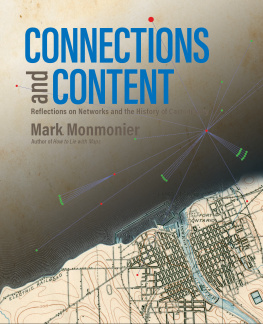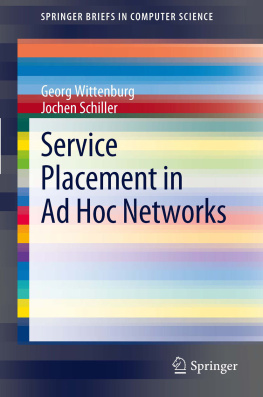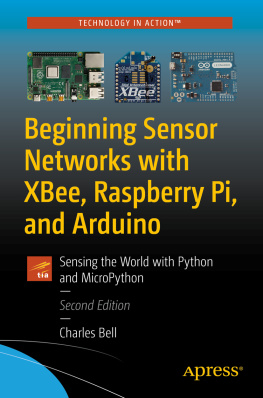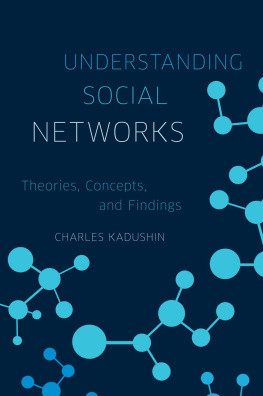Contents
Contents
Introduction to Networks of Networks
Jianxi Gao
Computer Science Department, Rensselaer Polytechnic Institute, Troy, New York, USA
Amir Bashan
Department of Physics, Bar-Ilan University, Ramat-Gan, Israel
Louis Shekhtman
Department of Physics, Bar-Ilan University, Ramat-Gan, Israel
Shlomo Havlin
Department of Physics, Bar-Ilan University, Ramat-Gan, Israel
IOP Publishing, Bristol, UK
IOP Publishing Ltd 2022
All rights reserved. No part of this publication may be reproduced, stored in a retrieval system or transmitted in any form or by any means, electronic, mechanical, photocopying, recording or otherwise, without the prior permission of the publisher, or as expressly permitted by law or under terms agreed with the appropriate rights organization. Multiple copying is permitted in accordance with the terms of licences issued by the Copyright Licensing Agency, the Copyright Clearance Centre and other reproduction rights organizations.
Permission to make use of IOP Publishing content other than as set out above may be sought at .
Jianxi Gao, Amir Bashan, Louis Shekhtman and Shlomo Havlin have asserted their right to be identified as the authors of this work in accordance with sections 77 and 78 of the Copyright, Designs and Patents Act 1988.
ISBN 978-0-7503-1046-8 (ebook)
ISBN 978-0-7503-1047-5 (print)
ISBN 978-0-7503-1820-4 (myPrint)
ISBN 978-0-7503-1116-8 (mobi)
DOI 10.1088/978-0-7503-1046-8
Version: 20220901
IOP ebooks
British Library Cataloguing-in-Publication Data: A catalogue record for this book is available from the British Library.
Published by IOP Publishing, wholly owned by The Institute of Physics, London
IOP Publishing, Temple Circus, Temple Way, Bristol, BS1 6HG, UK
US Office: IOP Publishing, Inc., 190 North Independence Mall West, Suite 601, Philadelphia, PA 19106, USA
Shlomo Havlin dedicates the book to his dear wife Hava.
Preface
The essence of network science is the realization that the behavior of many complex systems in nature and technology cannot be understood only by analyzing their components. Rather, the interactions between the components, considered as a network usually, play a critical role in the functioning of the system. Network science, initiated around the year 2000, has successfully formulated methodological frameworks and scientific tools to study complex systems composed of many interacting elements, leading to a deep and detailed understanding of their structural and functional fundamental features. A decade later, in 2010, scientists from diverse fields started to develop mathematical frameworks and study more complex scenarios where the networks themselves are interconnected and dependent on each other, forming networks of networks. These systems have also been referred to as interdependent networks, multilayer networks, multiplex networks or multidimensional networks.
In this book, we introduce the basic concepts and tools in the developing field of networks of networks, reviewing their fundamental features and new properties, while focusing especially on interdependent networks, which are unique since the interactions between the networks (dependency links) are different from the interactions within the networks (connectivity links). The book is intended both for readers who want a broad overview of the field as well as to those who are interested in a deeper exploration of the methods and applications of this new paradigm. To enable readers to dive deeper into the material, we have chosen to maintain the notation in equations from the original manuscripts where the results were published even though this may lead to differing notation throughout the book. We still believe that this supports further delving into the material through the original sources and have made sure to define variables clearly in each section they are used so that confusion will be avoided.
Ramat-Gan, Israel
Boston, MA, USA
January, 2022 | Jianxi Gao
Amir Bashan
Louis Shekhtman
Shlomo Havlin |
Acknowledgements
We would like to acknowledge all of the researchers who have contributed to the study of networks of networks including Ginestra Bianconi, Jose Mendes, Sergey Dorogovtsev, Gareth Baxter, Stefano Boccaletti, Vito Latora, Yamir Moreno, Jesus Gomez Gardenes, Alex Arenas, Jurgen Kurths, Mason Porter, James Gleeson, Mikko Kivela, Marc Barthelemy, Kwang Il-Goh, Byungnam Kahng, Peter Mucha, Raissa Dsouza, Janos Kertesz, and many others. We further thank our numerous collaborators in this field including Ivan Bonamassa, Michael Danziger, Yehiel Berezin, Sergey Buldyrev, Bnaya Gross, Dana Vaknin, Lidia Braunstein, Roni Parshani, Ronny Bartsch, Plamen Ivanov, Orr Levy, Alex Smolyak, Stefano Boccaletti, Yanqung Hu, Dror Kenett, Nadav Shnerb, Gene Stanley, Dong Zhou, Gaogao Dong, Reuven Cohen, Xin Yuan, Jingfang Fan, Lucas Valdez, Daqing Li, Xueming Liu, Xuqing Huang and many more.
Author biographies
Jianxi Gao

Dr Jianxi Gao has been an assistant professor in the Computer Science Department at Rensselaer Polytechnic Institute since 2017. Prior to joining the Computer Science at RPI, he was a Research Assistant Professor at the Center for Complex Network Research at Northeastern University, working with Prof. Albert-Lszl Barabsi. Dr Gao got his PhD degree in the Department of Automation at Shanghai Jiao Tong University in 2012. During his PhD studies from 2009 to 2012, he visited Prof. H. Eugene. Stanley in the Physics Department at Boston University, as well as Prof. Shlomo Havlin in the Physics Department at Bar-Ilan University in 2012. He received the NSF CAREER Award in 2021 to study the resilience of complex networks. His research focuses on using network theory, control theory, statistic physics, and operation research to understand, predict, and ultimately control complex systems' resilience and cascading failures in networks of networks. He has published over 80 papers in journals, such as Nature, Nature Physics, Nature Ecology & Evolution, Nature Communications, Proceedings of the National Academy of Sciences, Physical Review Letters, and more, and conferences such as AAAI, KDD, and IJCAI, with over 5000 citations on Google Scholar. Dr Gao has also been selected as the Editor board of Scientific Reports and Physica A, external editor of PNAS, distinguished referee of EPL and Elsevier.
Amir Bashan
Dr Amir Bashan is a principal investigator and senior-lecturer in the department of physics in Bar-Ilan university (BIU), Israel, since 2016. He completed his PhD studies in physics and network science in BIU, under the guidance of Prof. Shlomo Havlin in 2013. He then did postdoctoral research in the Channing Division of Network Medicine, Brigham and Women's Hospital and Harvard Medical School, Boston, USA, in the group of Prof. Yang-Yu Liu. Dr Bashan focuses on utilizing mathematical modeling and network theory and developing new computational methods to analyze heterogeneous high-throughput biological data, aiming to uncover general underlying principles that govern the functioning of large, complex systems.

